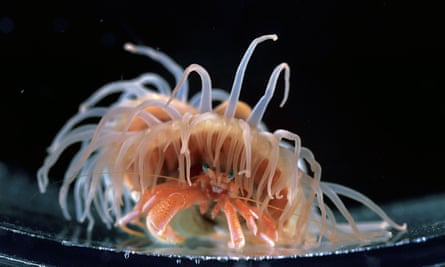[ad_1]
Deep in the Kumano Sea off the south-eastern coast of Japan, hermit crabs crawl around sporting what look like pearly pink flowers on their shells. But these are not floral arrangements – they are members of a newly discovered species of sea anemone, Stylobates calcifer, which live on the hermit crabs’ shells.
This kind of sea anemone and hermit crab cohabitation is not unique: dozens of anemone species live exclusively with hermit crabs. It’s a win-win situation – the anemones’ petal-like stinging tentacles protect the crabs from predators, while they hitch rides to new feeding grounds and get leftover scraps of the crab’s food.
But this new anemone species goes one step further – it extends the hermit crab’s home. The anemone secretes a covering over the snail shell in which the crab lives and, when it reaches the edges, it just keeps going – rather like building the crab a veranda on the front of its house.

And they will not just build extensions for anyone. “This sea anemone is home for only one hermit crab species,” says Akihiro Yoshikawa, from Kagoshima University, who discovered the anemone when several were brought up in trawlers’ nets from 100 to 400 metres (330-1,300ft) down.
So it is perhaps no surprise that hermit crabs are keen to keep hold of their petally pals and, when the time comes for a crab to move into a new snail shell, it takes its anemone with it.
Yoshikawa named the sea anemone calcifer after a character in one of his favourite childhood films, the 2004 animation Howl’s Moving Castle. The film is an adaptation of the fantasy novel of the same name in which Calcifer, a fire demon, is bound by a magical pact to the wizard Howl’s castle, which moves about from place to place – much like a hermit crab.
But moving one’s sea anemone is no easy task. Yoshikawa was lucky enough to film a crab-calcifer anemone duo in an aquarium in his laboratory as they moved shells – something nobody had ever seen before. The crab took almost two days to painstakingly pinch, prod and cajole the anemone until it eventually let go of the old shell and fixed on to the new one.
Yoshikawa found plenty of crabs without stinging companions, which suggests calcifer sea anemones are in short supply in the deep sea. This is probably another reason why the crabs go to such trouble to keep their anemones. But it does not explain why hermit crabs risk moving shells when their anemones could so easily be stolen mid-transfer – especially when these handy shell friends can build extensions for growing crabs.
Some of the answer may be that the anemone’s expanded shell is not an ideal home for the hermit crabs. “I think the crabs consider the anemone’s shell as a temporary home,” says Yoshikawa, noting that the extended structure “is very thin and not strong compared with the snail shell”.
Plus, moving house is a good way to get rid of unwanted visitors. Hundreds of other species live on and inside hermit crab shells, but not all of them are welcome. Scale worms take up residence, stealing the hermit crabs’ food and gorging themselves on their eggs. Yoshikawa thinks the hermit crabs may swap shells to escape.
Curious to know what calcifer sea anemones eat, Yoshikawa offered his captive specimen a selection of delicacies – including skipjack tuna and live shrimp – which it mostly ignored. He thinks the anemones swallow small particles of organic matter that fall down into the deep sea, known as “marine snow”. The anemones fix on to the backs of hermit crabs, hoisting themselves off the seabed with their mouths upturned in an ideal snow-catching position.
[ad_2]
#Discovered #deep #superbuilder #sea #anemones #verandahs
( With inputs from : www.theguardian.com )

Leave a Reply